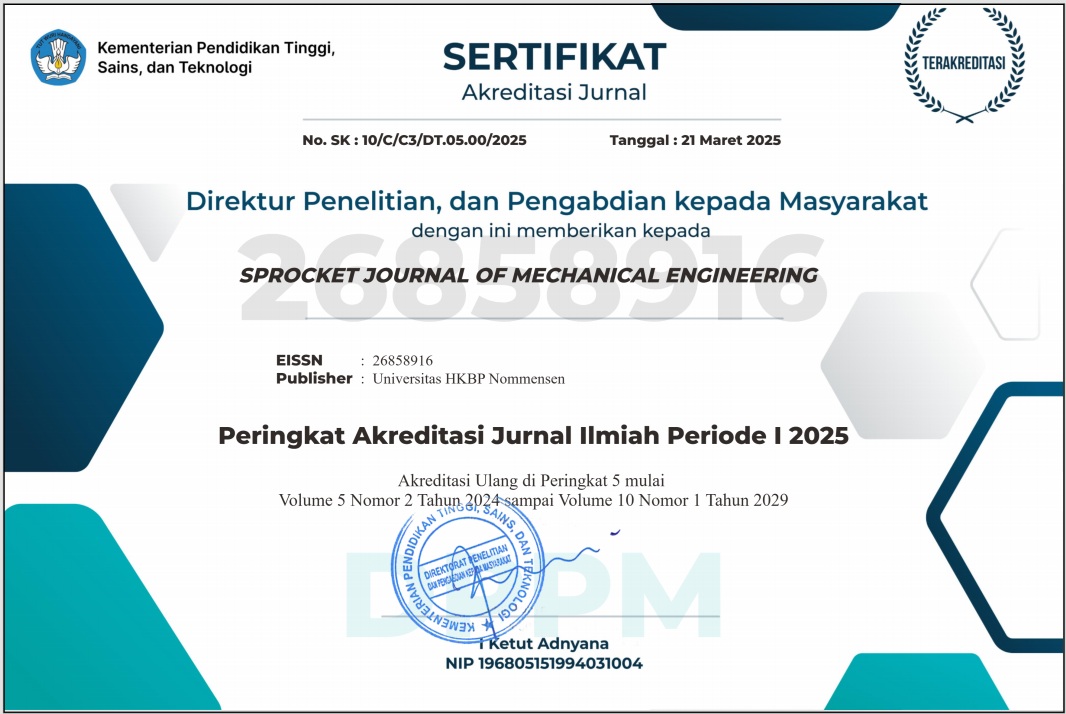Pengaruh Kecepatan, Temperatur dan Infill Terhadap Kualitas dan Kekasaran Kotak Relay Lampu Sign Sepedamotor Hasil dari 3D Printing
Abstract
3D printing technology has great potential in today's manufacturing world where one of its uses is in the prototype of a product. One of the most famous and inexpensive 3D printing technologies is the Fused Deposition Modeling (FDM) method. Many studies have been carried out using this FDM method.
In this study, the printing of motorbike light relay boxes was carried out using the FDM method with two variations of speed, temperature and infill of each mass. 3D Printing uses a nozzle diameter of 0.4 mm and a work table temperature of 60oC and a height of 0.2 mm for each layer with support every where. From the research results, all the products produced have a rough surface with a level of geometric accuracy ranging from 0.91% for the length dimension and 7.73% for the width dimension of the product.
References
[2]. Wandro J. Siregar, Richard A. M. Napitupulu, Parulian Siagian, “Desain dan manufaktur model piston Jupiter MX 135 cc dengan menggunakan 3D printer”, SJoME Vol. I No. 2, Maret 2020.
[3]. Franando, Ahmad Zamheri, Fatahul Arifin, “Studi pembuatan bagian alat rehabilitasi penderita stroke dengan pendeekatan metode Taguchi”, Machinery Jurnal Teknologi Terapan Vol.1 No.1, Agustus 2020.
[4]. Andik Aris Setiawan, Bayu Wiro Karuniawan, Nurvita Arumsari, “Optimasi parameter 3D printing terhadap keakuratan dimensi dan kekasaran permukaan produk menggunakan metode Taguchi Grey Relational Analysis”, Proceedings conference on design manufacture engineering and its application, Politeknik Perkapalan Negeri Surabaya, Desember 2018.
[5]. Sobron Lubis, Sofyan Djamil, Yolanda, “Pengaruh orientasi objek pada proses 3D Printing bahan polymer PLA dan ABS terhadap kekuatan tarik dan ketelitian dimensi produk”, SINERGI Vol. 20, No. 1, Februari 2016.
[6]. Hamid Abdillah, Ulikaryani, “Aplikasi 3D Printer Fused Deposite Material (FDM) pada pembuatan pola cor”, SINTEK JURNAL, Vol. 13 No. 2, Desember 2019.
[7]. Ikhwan Taufik, Herru Santosa Budiono, Herianto, Deni Andriyansyah, “Pengaruh printing speed terhadap tingkat kekasaran permukaan hasil additive manufacturing dengan Polylactic Acid filament”, Journal of Mechanical Engineering, Vol. 4, No. 2, September 2020
[8]. Benny Haddli Irawan, Rahman Hakim, Hanifah Widiastuti, Domi Kamsyah1, Bambang Sahputra, “Pengaruh temperature nozzle dan base plate pada mesin Leapfrog Creatr 3D Printer terhadap density dan surface roughness material ABS”, Jurnal Teknologi dan Riset Terapan (JATRA) Volume 1, Nomor 1 (Juni 2019)

This work is licensed under a Creative Commons Attribution 4.0 International License.
Penulis yang menerbitkan dengan SPROCKET JOURNAL OF MECHANICAL ENGINEERING menyetujui ketentuan berikut :
- Penulis memegang hak cipta dan memberikan jurnal hak penerbitan pertama dengan karya yang dilisensikan secara bersamaan di bawah Lisensi Internasional Creative Commons Atribusi 4.0 . yang memungkinkan orang lain untuk berbagi karya tersebut dengan pengakuan atas kepengarangan karya dan penerbitan awal dalam jurnal ini.
- Penulis dapat membuat pengaturan kontraktual tambahan yang terpisah untuk distribusi non-eksklusif atas versi jurnal yang diterbitkan dari suatu karya (misalnya, mempostingnya ke repositori institusional atau menerbitkannya dalam sebuah buku), dengan pengakuan atas penerbitan awalnya di jurnal ini.
- Penulis diizinkan dan didorong untuk mengunggah karya mereka secara daring (misalnya, di repositori institusi atau di situs web mereka) sebelum dan selama proses penyerahan, karena hal ini dapat mengarah pada pertukaran yang produktif, serta kutipan yang lebih awal dan lebih banyak dari karya yang diterbitkan (Lihat Pengaruh Akses Terbuka ).






.png)
.png)

